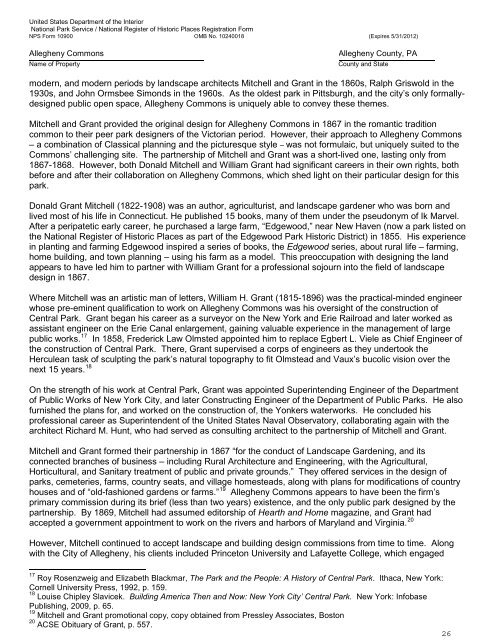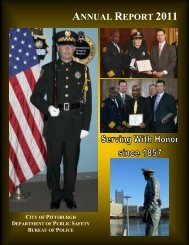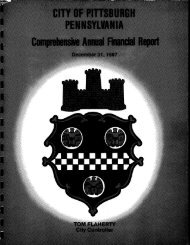Allegheny Commons - City of Pittsburgh
Allegheny Commons - City of Pittsburgh
Allegheny Commons - City of Pittsburgh
You also want an ePaper? Increase the reach of your titles
YUMPU automatically turns print PDFs into web optimized ePapers that Google loves.
United States Department <strong>of</strong> the InteriorNational Park Service / National Register <strong>of</strong> Historic Places Registration FormNPS Form 10900 OMB No. 10240018 (Expires 5/31/2012)<strong>Allegheny</strong> <strong>Commons</strong>Name <strong>of</strong> Property<strong>Allegheny</strong> County, PACounty and Statemodern, and modern periods by landscape architects Mitchell and Grant in the 1860s, Ralph Griswold in the1930s, and John Ormsbee Simonds in the 1960s. As the oldest park in <strong>Pittsburgh</strong>, and the city’s only formallydesignedpublic open space, <strong>Allegheny</strong> <strong>Commons</strong> is uniquely able to convey these themes.Mitchell and Grant provided the original design for <strong>Allegheny</strong> <strong>Commons</strong> in 1867 in the romantic traditioncommon to their peer park designers <strong>of</strong> the Victorian period. However, their approach to <strong>Allegheny</strong> <strong>Commons</strong>– a combination <strong>of</strong> Classical planning and the picturesque style – was not formulaic, but uniquely suited to the<strong>Commons</strong>’ challenging site. The partnership <strong>of</strong> Mitchell and Grant was a short-lived one, lasting only from1867-1868. However, both Donald Mitchell and William Grant had significant careers in their own rights, bothbefore and after their collaboration on <strong>Allegheny</strong> <strong>Commons</strong>, which shed light on their particular design for thispark.Donald Grant Mitchell (1822-1908) was an author, agriculturist, and landscape gardener who was born andlived most <strong>of</strong> his life in Connecticut. He published 15 books, many <strong>of</strong> them under the pseudonym <strong>of</strong> Ik Marvel.After a peripatetic early career, he purchased a large farm, “Edgewood,” near New Haven (now a park listed onthe National Register <strong>of</strong> Historic Places as part <strong>of</strong> the Edgewood Park Historic District) in 1855. His experiencein planting and farming Edgewood inspired a series <strong>of</strong> books, the Edgewood series, about rural life – farming,home building, and town planning – using his farm as a model. This preoccupation with designing the landappears to have led him to partner with William Grant for a pr<strong>of</strong>essional sojourn into the field <strong>of</strong> landscapedesign in 1867.Where Mitchell was an artistic man <strong>of</strong> letters, William H. Grant (1815-1896) was the practical-minded engineerwhose pre-eminent qualification to work on <strong>Allegheny</strong> <strong>Commons</strong> was his oversight <strong>of</strong> the construction <strong>of</strong>Central Park. Grant began his career as a surveyor on the New York and Erie Railroad and later worked asassistant engineer on the Erie Canal enlargement, gaining valuable experience in the management <strong>of</strong> largepublic works. 17 In 1858, Frederick Law Olmsted appointed him to replace Egbert L. Viele as Chief Engineer <strong>of</strong>the construction <strong>of</strong> Central Park. There, Grant supervised a corps <strong>of</strong> engineers as they undertook theHerculean task <strong>of</strong> sculpting the park’s natural topography to fit Olmstead and Vaux’s bucolic vision over thenext 15 years. 18On the strength <strong>of</strong> his work at Central Park, Grant was appointed Superintending Engineer <strong>of</strong> the Department<strong>of</strong> Public Works <strong>of</strong> New York <strong>City</strong>, and later Constructing Engineer <strong>of</strong> the Department <strong>of</strong> Public Parks. He als<strong>of</strong>urnished the plans for, and worked on the construction <strong>of</strong>, the Yonkers waterworks. He concluded hispr<strong>of</strong>essional career as Superintendent <strong>of</strong> the United States Naval Observatory, collaborating again with thearchitect Richard M. Hunt, who had served as consulting architect to the partnership <strong>of</strong> Mitchell and Grant.Mitchell and Grant formed their partnership in 1867 “for the conduct <strong>of</strong> Landscape Gardening, and itsconnected branches <strong>of</strong> business – including Rural Architecture and Engineering, with the Agricultural,Horticultural, and Sanitary treatment <strong>of</strong> public and private grounds.” They <strong>of</strong>fered services in the design <strong>of</strong>parks, cemeteries, farms, country seats, and village homesteads, along with plans for modifications <strong>of</strong> countryhouses and <strong>of</strong> “old-fashioned gardens or farms.” 19 <strong>Allegheny</strong> <strong>Commons</strong> appears to have been the firm’sprimary commission during its brief (less than two years) existence, and the only public park designed by thepartnership. By 1869, Mitchell had assumed editorship <strong>of</strong> Hearth and Home magazine, and Grant hadaccepted a government appointment to work on the rivers and harbors <strong>of</strong> Maryland and Virginia. 20However, Mitchell continued to accept landscape and building design commissions from time to time. Alongwith the <strong>City</strong> <strong>of</strong> <strong>Allegheny</strong>, his clients included Princeton University and Lafayette College, which engaged17 Roy Rosenzweig and Elizabeth Blackmar, The Park and the People: A History <strong>of</strong> Central Park. Ithaca, New York:Cornell University Press, 1992, p. 159.18 Louise Chipley Slavicek. Building America Then and Now: New York <strong>City</strong>’ Central Park. New York: InfobasePublishing, 2009, p. 65.19 Mitchell and Grant promotional copy, copy obtained from Pressley Associates, Boston20 ACSE Obituary <strong>of</strong> Grant, p. 557.26
















